relief; bas-relief
relief is a branch of sculpture where figures project from a flat surface.
a bas-relief is a relief where figures project less than half their true depth. It is adopted for works which are seen at a short distance. For example the reliefs of Colonna Traiana,
which were seen from buildings (now lost) next to the column have a lower projection than the reliefs of
Colonna Antonina which were seen from the street level.
The image shows a bas-relief in the baptistery chapel of S. Maria del Popolo in Rome. | 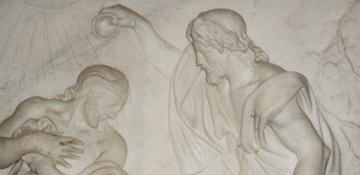 |
relief; high relief
a high relief is a relief where some figures fully project from the background surface.
Some sculptors
developed a special skill for reliefs. In Rome Andrea Bregno at the end of the XVth century and Alessandro Algardi in the XVIIth century
were particularly famous for their reliefs.
The image shows a high relief by Ambrogio Buonvicino on the fašade of S. Pietro in Rome. | 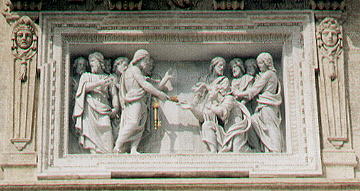 |
rose window
a rose window is a large circular window above the entrance of a church. It is usually decorated and split into sections.
The image shows the rose window of S. Giovanni Battista dei Gerosolimitani in Corneto (Tarquinia). | 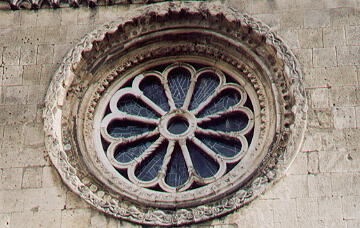 |
sarcophagus
a sarcophagus is a wood, stone, terracotta or marble coffin.
The word has a rather gruesome
etymology as it means meat eater.
The ancient Romans decorated their sarcophagi with reliefs and very often
with a curved decoration which is called strigilato after strigil a double curved tool they used
to scrape oil or sweat from the skin.
The image shows a Roman sarcophagus "strigilato" in Zagarolo. | 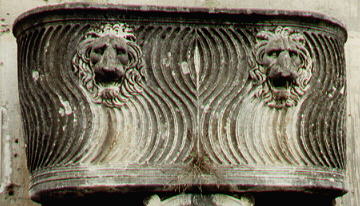 |
Serliana
Serliana is a window with three openings designed
following a pattern given by Sebastiano Serlio (1475-1554) in his Trattato di Architettura a treaty which greatly influenced the architecture of the Late Renaissance.
The serliana pattern was used also for loggias (see S. Maria in Via Lata).
The image shows a detail of Villa Aldobrandini in Frascati. | 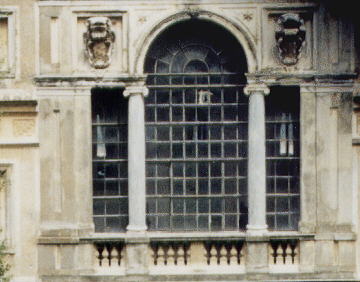 |
solomonic
a solomonic (or vineal) column is a spiral
column decorated with branches of vine or laurel. It is called solomonic because the columns brought to Rome after the sack of
Solomon's Temple in Jerusalem had this shape. The columns were donated by Constantine to the pope to build the old basilica of S. Pietro.
Bernini put these columns in the upper part of the piers supporting the dome of new S. Pietro.
You can see them in a page devoted to What Mark Twain Saw in Rome.
The image shows a detail of a house in the Grand Place of Brussels. | 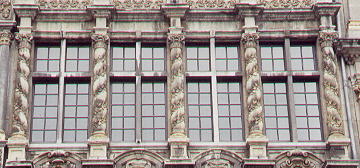 |
trophy
trophy is a group of war related objects arranged to form an ornament.
Examples
of Roman trophies can be seen in Piazza del Campidoglio.
The image shows a XVIIth century trophy in S. Maria della Vittoria. The trophy
celebrated the victory in 1620 of the (Catholic) Austrian army at the White Mountain near Prague. | 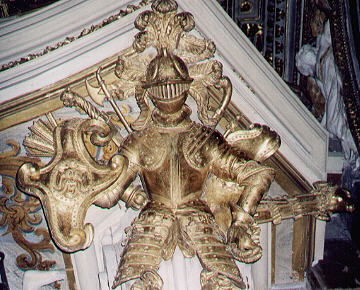 |
Vitruvian opening
Vitruvius was a Roman architect who dedicated to the emperor
Augustus a treaty (De Architectura) which soon became the most comprehensive summary of classical architecture. The treaty was rediscovered in 1414 and it
had a great influence on Renaissance architects from Leon Battista Alberti to Andrea Palladio.
In this text Vitruvius described an entrance to a building tapered towards its top. It was typical of Ancient Egypt and it
became very much in fashion in the funerary monuments of the Neoclassic period.
The images show the side entrances of Collegio Romano and of Palazzo di Propaganda Fide in Rome. Another example
of Vitruvian opening can be found in Carceri Nuove. | 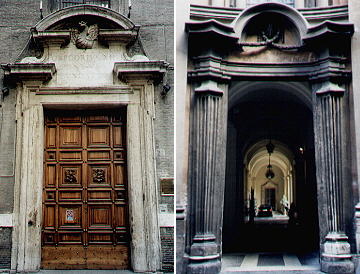 |
Vitruvian scroll
Vitruvian scroll is a very ancient decorative theme described by the Roman architect Vitruvius in a treaty which is the only one
surviving text from antiquity on this subject.
The image shows a detail of a Roman mosaic in Antiochia, Turkey. The central part of the mosaic
shown in the image is a decoration portraying acanthus leaves. | 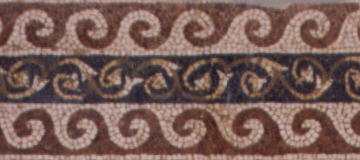 |
volute
volute is a decorative theme consisting in a spiral and it is typical of
the Ionic order.
It was used by many Renaissance architects to link the lateral and lower portions of a fašade to its central higher part.
The image shows a detail of S. Maria ai Monti in Rome. | 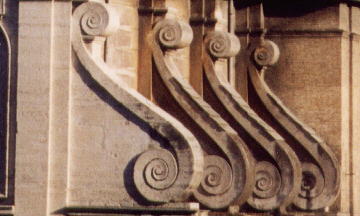 |


 or to
The Coats of Arms of the Popes or
to My Home Page on Baroque Rome or to
My Home Page on Rome in the footsteps of an XVIIIth century traveller
or to
The Coats of Arms of the Popes or
to My Home Page on Baroque Rome or to
My Home Page on Rome in the footsteps of an XVIIIth century traveller









